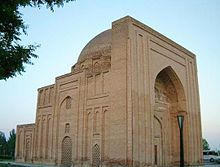Tus, Iran
توس | |
Razavi Khorasan Province, Iran | |
| Coordinates | 36°28′45.0″N 59°30′35.0″E / 36.479167°N 59.509722°E |
|---|---|
| Type | Settlement |
| Site notes | |
| Condition | In ruins |


Tus (
Ancient Greek: Σούσια). It was also known as Tusa.[1] Tus was divided into four cities, Tabran, Radakan, Noan and Teroid. The whole area which today is only called Tus was the largest city in the whole area in the fifth century.[2]
History
According to legend
Zoroastianism.[3] It was captured by Alexander the Great
in 330 BCE.
Tus was taken by the
Abu Muslim Khorasani defeated the Umayyad governor during the Abbasid Revolution.[4] In 809, the Abbasid Caliph Harun al-Rashid fell ill and died in Tus, on his way to solve the unrest in Khorasan.[5] His grave is located in the region.[6]
In 1220, Tus was sacked by the Mongol general, Subutai, and a year later Tolui would kill most of its populace,[7] and destroying the tomb of Caliph Harun al-Rashid in the process.[8] Decades later, Tus would be rebuilt under the governorship of Kuerguez.[8]
The most famous person who has emerged from that area is the poet
Sufi mystic and historian Abu Nasr as-Sarraj.[9]
Registration of Ferdowsi's Tomb in UNESCO
Ferdowsi Tomb has been
World Heritage List.[10]
See also
- Al-Tusi – a descriptor used for individuals associated with Tus
- Tus citadel
References
- ^ Keall, E., M. Roaf, R. Talbert, T. Elliott, S. Gillies. "Places: 952108 (Tusa/Sousia)". Pleiades. Retrieved January 5, 2015.
{{cite web}}: CS1 maint: multiple names: authors list (link) - ^ The Ancient City of Toos-Tus- [verification needed]
- ^ Justi: Iranisches Namenbuch, 1963, p. 157.
- '^ Tus, V. Minorsky, The Encyclopaedia of Islam, ol. X, ed. P.J. Bearman, T. Bianquis, C.E. Bosworth, E. van Donzel and W.P. Heinrichs, (Brill, 2000), 741.
- ISBN 0 297 83000 7)
- ^ Hudud al-Alam translated by V. Minorsky (SBN 7189 -2-1 7)
- ^ Tus, Gisela Helmecke, Medieval Islamic Civilization: An Encyclopedia, Vol. I, ed. Josef W. Meri, (Routledge, 2006), 838.
- ^ a b Mediaeval Researches from Eastern Asiatic Sources, Vol. 2, ed. E. Bretschneider, (Routledge, 2000), 65.
- ISBN 9780195125580. Retrieved 24 April 2018.
- ^ WCHV (2021-07-18). "Campaign for Registering Ferdowsi's Hometown as a World Cultural Heritage Site". Retrieved 2022-03-21.
Sources
- ISBN 978-0-521-20093-6.
- Litvinsky, Ahmad Hasan Dani (1998). History of Civilizations of Central Asia: Age of Achievement, A.D. 750 to the end of the 15th-century. UNESCO. ISBN 9789231032110.
- Khaleghi-Motlagh, Djalal (1993). "DAQĪQĪ, ABŪ MANṢŪR AḤMAD". Encyclopaedia Iranica, Vol. VI, Fasc. 6. pp. 661–662.
External links
 Media related to Tus, Iran at Wikimedia Commons
Media related to Tus, Iran at Wikimedia Commons- Livius.org: Susia (Tus)

